Leigh Martin loves plants. In fact, she admits she is obsessed with them. “My education, career, and artwork revolve around this love, and there are few things that I love more.”
Except perhaps knitting. While she has been knitting since college (mostly garments and gifts) it was only a few years ago that she thought about branching out into more sculptural forms. Given her plant obsession, fungi seemed to be a natural choice. “I think about nature all the time, since it’s what I work with every day. When I come home, I think about my craft. Some women like to buy shoes; I like to buy plants and yarn.”
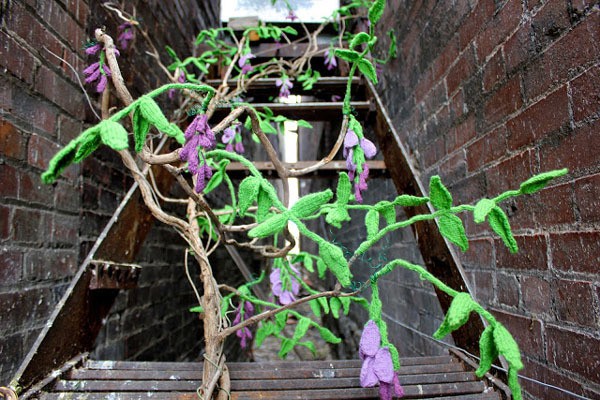
leigh martin – dyed-in-the-wool project (installation)

leigh martin – dyed-in-the-wool project (detail)
Leigh works in urban forestry, so she spends a lot of time outdoors. She told me that one of the reasons for pursuing forestry was for the outreach aspect – to help people become more aware of their natural surroundings, and to understand how nature can benefit them. This is where the idea for her first sculptural installation came from.
“The Decomposition series (Colony I and Colony II) came about after my husband and I went on our honeymoon to Costa Rica. We were in the rainforest crouching down next to this rotting log that was completely covered in the smallest mushrooms I had ever seen. One would think that even up close they would just look like solid white, smooth forms, but even as small as they were there was so much intricacy and so much texture. I remember thinking to myself, “How could someone NOT be amazed by this?””
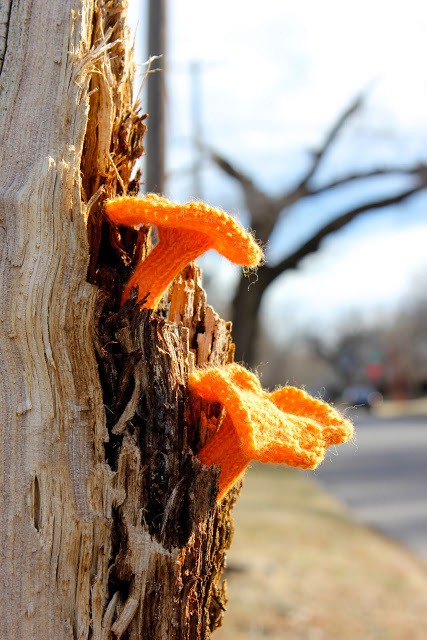
leigh martin – 52 forms of fungi – jackolantern
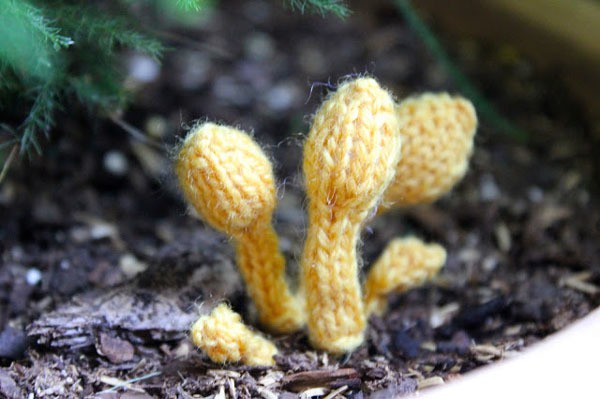
leigh martin – 52 forms of fungi – yellow house fungus
“I was observing it because I regularly observe these types of things, but how many people just walk by without stopping to look? After that the idea came to me to knit replicas of different types of fungi, and place them in a realistic setting. From afar the pieces look like they are supposed to be there, and as one gets closer they realize that the forms are not in fact mushrooms at all, but a fiber installation. My goal is just to get someone to stop and look, and to think about what they’re looking at.””
She worked on the tiny mushrooms for months leading up to a trip to Oregon, and installed both of the collections there. “It was a very exciting time, and very satisfying to see it come to fruition. I thoroughly enjoyed it.”
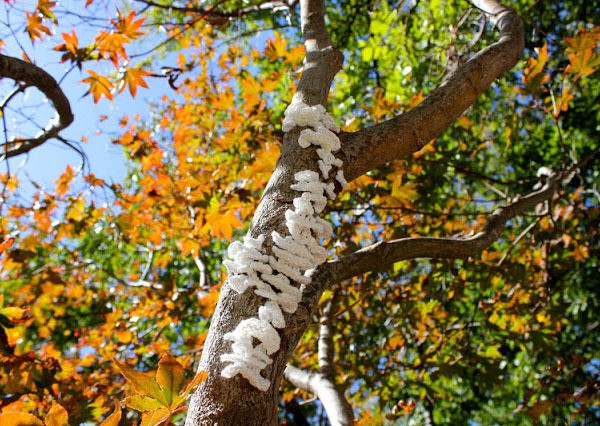
leigh martin – decomposition – stacks
Ironically, Leigh was never interested in knitting as a child, despite the fact that her mother was a keen maker and always had knitting around. “While she taught me multiple times growing up it never really stuck until I was in college. It’s funny that I’m so obsessed with knitting now. As a kid, Mom would take me to the yarn store and I would be bored to death! Now I have to control myself because I just want to buy everything…”
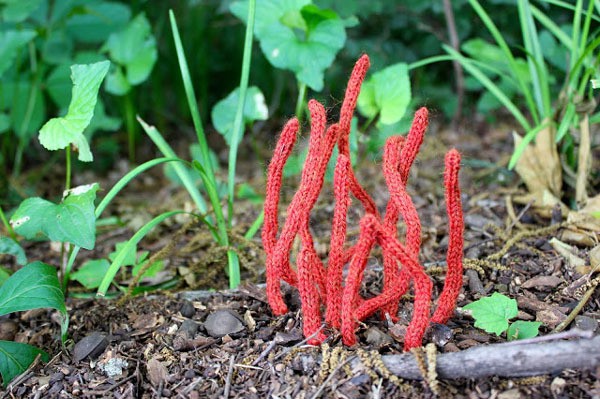
leigh martin – 52 forms of fungi – coral fungus
Despite the obvious knowledge of her craft, or indeed, because of it, she confessed that for most part when it comes to technique she just “wings it”. Firstly checking out the shape, texture and colour of what she wants to make, she then just tests out a pattern on the go. She says sometimes it works out, and sometimes it doesn’t.
I asked Leigh what her worst experience was with knitting.
She answered, “It took me a little while to understand the importance of knitting a gauge swatch. I probably don’t need to explain any more about that…”
“Knitting all of the pieces is a big aspect of my work, but for my larger installations the most important part is the setting and placement. It’s strange spending so many hours working on something and not really seeing it come together until the end… especially not really knowing how it’s going to look when it’s done. I basically hike along until I find the “perfect” spot, and then place the forms as it strikes me. It’s almost like a stream of consciousness, or a meditative practice. I think that’s partly what I enjoy so much about doing it; it’s very liberating to not have the ability to control everything about it… I just have to go with the flow.”
Inspiration for each project comes through spending time outdoors, hiking, camping, walking the dog. All the while, she is checking out fungi, interesting plants and trees, and anything else that catches her eye. “Sometimes I will see a type of fungi that interests me, so I will come home and research it in my field guides and on the internet and then come across something else that’s completely amazing.” Other inspiration comes from artists such as the extraordinary and ephemeral work of Andy Goldsworthy, (another lover of the outdoors and nature) with his installations using natural materials found on site.
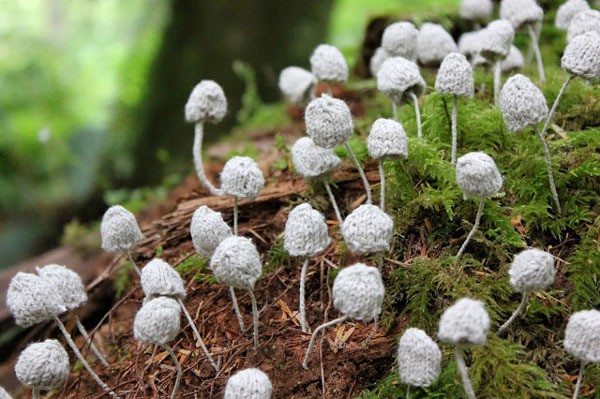
leigh martin – decomposition – colony I
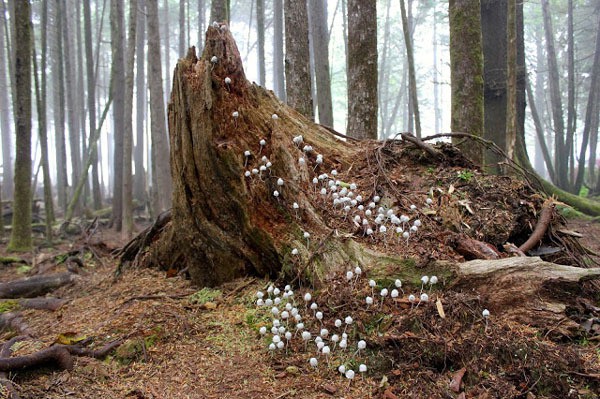
leigh martin – decomposition – colony II
The best thing for her about seeing an artwork completed and installed is the sense of personal accomplishment. “It feels pretty amazing to have a vision, to work on it for a long period of time and then see it through to the finish. There’s really nothing like it.”
Her favourite quote is a passage from The Alchemist, by Paulo Coehlo. She said it has had a big impact on her adult life.
” ‘Well then, why should I listen to my heart?’
‘Because you will never again be able to keep it quiet. Even if you pretend not to have heard what it tells you, it will always be there inside you repeating to you what you’re thinking about life, and about the world.’ “
*
You can find more of Leigh’s wonderful work on her blog, www.bromeleighad.com, which has links to her shop where you can find prints of the photos from the installations.

Adorable! The larger pic at the end is fantastic. Love seeing them in a wider context as well.
I know! It makes them look all that more real and intriguing because you know they’re not.
That is awesome! Argh the little mushrooms are SO CUTE!
that they are Sophie! You must check out the rest of her 52 Forms of Fungi series, you’d love it 🙂